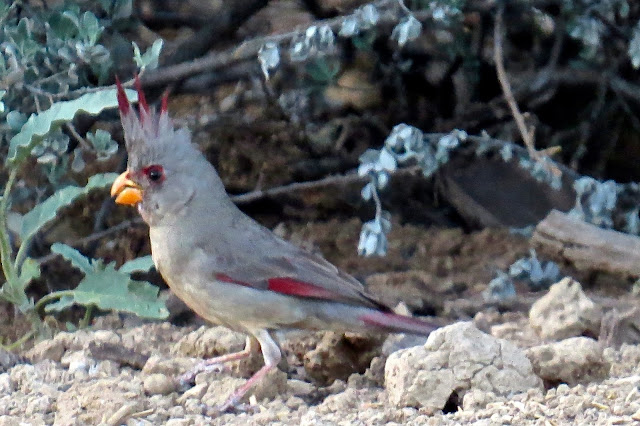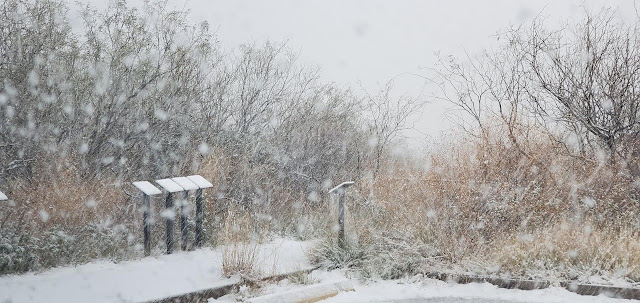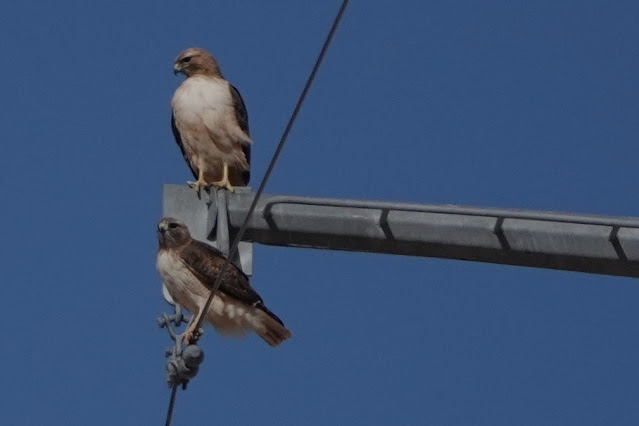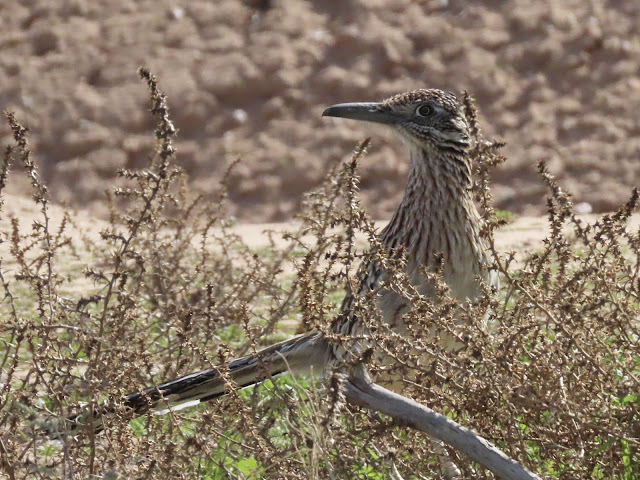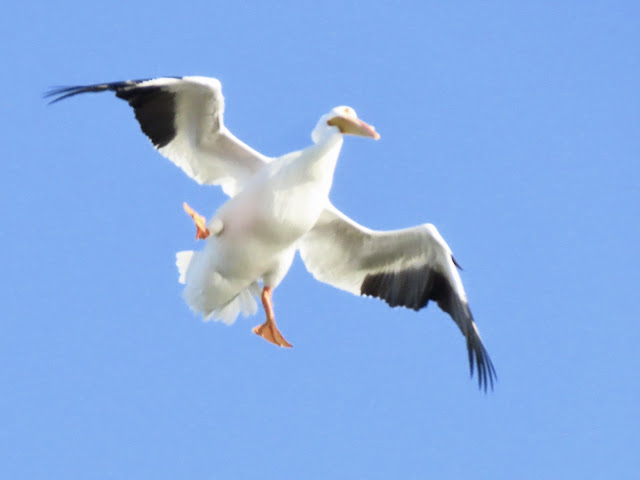DAY #1: Sunday, January 22, 2023
Having scrapped our plan for this trip last weekend with a rainy forecast, Glenda and I set off on a cold dark morning headed for Rio Rico near the Mexican border.
Sunday mornings are great travel days to reach more distant locations like this. Reaching the Picacho area in good time via shortcut, we continued to move well down I-10 with few trucks jockeying for lanes on the heavily traveled road to the I-19 exit.
Three and half hours after leaving home, we pulled into the empty parking area in front of well-marked Santa Gertrudis Lane along the I-19 frontage road. (Exit Tumacacori-Carmen and turn left to go north on the Frontage Road). Temperature was 35℉ at 8:30 a.m. We were prepared for two days of cold weather with clouds perhaps the following afternoon.
Would birds be out in such cold weather? Well, look at that - a little brown bird by a fence! Foraging on our side of the fence, a fluffed-up HERMIT THRUSH was our first bird of the trip. Where on past trips we had found the tree line on the south side of the walking entrance to the trailhead full of birds, today there was not a peep. Heading past the trailhead to check the Santa Cruz River area, we did find birds out and about. A truck came from the opposite direction, fording the fairly high River with no problem. Birds near the River included BLACK PHOEBE, RUBY-CROWNED KINGLET, EUROPEAN STARLING, COMMON RAVEN, and WHITE-WINGED DOVE.
Where on past trips we had found the tree line on the south side of the walking entrance to the trailhead full of birds, today there was not a peep. Heading past the trailhead to check the Santa Cruz River area, we did find birds out and about. A truck came from the opposite direction, fording the fairly high River with no problem. Birds near the River included BLACK PHOEBE, RUBY-CROWNED KINGLET, EUROPEAN STARLING, COMMON RAVEN, and WHITE-WINGED DOVE.
Strolling the de Anza trail provided a few opportunities to photograph the birds we spotted, including AMERICAN ROBIN, WILSON'S WARBLER, and a PYRRHULOXIA.
Male WILSON'S WARBLER Babs-file folder
Continuing north on the Frontage Road, our next stop was AMADO Water Treatment Plant Pond where we hoped to find the female Greater Scaup but after looking at each of the waterfowl, we ended up without it. Lots of other ducks were swimming, loafing, and foraging. 
RED-TAILED HAWK Photo by Babs
Continuing northward, we stopped for a short while around noontime at Montosa Canyon where birds were quiet. We chose to stay in one place on the trail beside the culvert. Birds came to check us out. Two HUTTON'S VIREO, four WESTERN BLUEBIRD, one BLACK PHOEBE, and several other birds gave us the once over.
HUTTON'S VIREO from Babs' files
WESTERN BLUEBIRD Babs' files
Ready, then to enjoy the wonderful Canoa Ranch Conservation Park, we were disappointed in the change of weather, not predicted. Cloudy sky and blustery wind kept songbirds low and mostly out of sight. But the number of waterfowl seems to increase at the pond each time I visit so we lucked out in that area.
PIED-BILLED GREBE by Babs
REDHEAD with pond grass - by Babs
RED-TAILED HAWK - by Babs
Young male VERMILION FLYCATCHER by Glenda Jones
By the time we finished walking the grounds at Canoa Ranch Preserve, I opted to fill the gas tank prior to heading to our overnight motel in Green Valley. Then we crashed, sorted photos, and enjoyed great food at the 9-Hole Restaurant.
DAY TWO, Monday, January 23, 2023
Again, weather forecast missed this morning by a long shot!
As the car climbed beyond the foothills of Madera Canyon, snowflakes began hitting the windshield. We looked at each other astonished and sort of, "WOW!"
As the snow began accumulating on the ground and roadway, I pulled into the parking area for the Proctor Road hiking/birding trail. We stayed long enough for Glenda to take a photo to prove this unlikely scenario in our desert-life mindset.
Leaving our tire tracks for the continuing snow to fill, I pulled out onto the roadway continuing up toward other birding hot spots. Not wanting to get out into the stuff and get wet, Glenda checked the immediate forecast and declared that "the rain in Green Valley will stop in an hour."
Birding by car, then, we collected a few sparse flitting birds as I crunched through the snow to a slightly higher altitude. It was now 24℉. Stopping when we reached Kubo Cabins at a mile high, we allowed the beauty of the snow-covered preserve to quiet us.
Birds were happy for the filled feeders. Photo by Glenda
When the snow stopped, we drove the short distance to Santa Rita Lodge where suet and seed-feeding stations were being claimed and fought over by hungry birds. We were among the first birders to enjoy this manifestation of every bird on our want-to-see list.
YELLOW-EYED JUNCO - by Babs
Kubo Cabins winter wonderland along stream by Babs
Our only brown and white woodpecker, the ARIZONA WOODPECKER, is below.
 At Santa Rita Lodge By Babs
At Santa Rita Lodge By Babs Mexican Jay not used to being scolded, gave up its platform to the arriving male HEPATIC TANAGER, one of our target birds. PHOTO by Glenda.TOWNSEND'S WARBLER Photo by Glenda
PAINTED REDSTART -- normally very active with constant fanning and flicking wings and tail, it was subdued on the snowy ground. Photo by Glenda.
Compare this female HEPATIC TANAGER to the male three photos above defending its arrival at a feeding station. Photo by Babs A female RIVOLI'S HUMMINGBIRD was the only one we spotted. Photo by Babs
View this checklist online at https://ebird.org/checklist/S126793911
***
Departing for our next birding stop along our route home, we left Madera Canyon and I-19, reaching Santa Cruz Flats a little after the noon hour. Clear sky, calm wind, and 46℉.
LOGGERHEAD SHRIKE By Glenda
HORNED LARK By Glenda
Two RED-TAILED HAWK By Glenda
GREATER ROADRUNNER
By Babs MOUNTAIN BLUEBIRD By Glenda Driving a bit farther within the Flats, we checked out Evergreen Turf Sod Farm for MOUNTAIN PLOVER. We found five (along with other birds) at that location. Plovers were really beyond my camera's ability but I post on eBird to show that I was at least there and that birds were far out from the road.
The two-day birding trip was definitely worth our time and effort. Nature speaks to us. Today, I was particularly delighted to see several LOGGERHEAD SHRIKE along the way as they have been scarce the past few years (or I've been there at the wrong times). The snow was an extraordinary experience for me, having lived in the desert for 30 years now. Glenda, from Canada, found it fascinating but definitely not expected.
* * *




